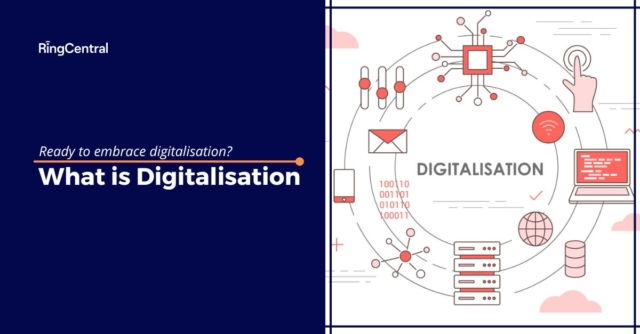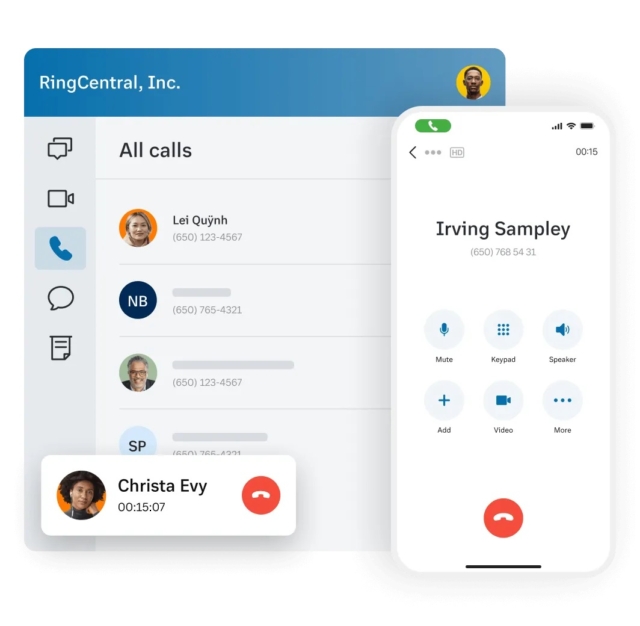When was the last time you sat and read the newspaper front to back?
It’s safe to say that, like a lot of people these days, you probably get the majority of your news from apps, websites and social media on your phone. And while you still might read a physical newspaper from time to time, you’ve probably fully adapted to the digitalisation of news.
According to Gartner, 91% of organisations are engaged in some form of digital initiative. If you’ve started your business’s digital transformation, pat yourself on the back and keep going. If you haven’t, there’s no time to waste because you don’t want to become obsolete in this digitalised world.
What is Digitalisation?
Digitalisation is the adoption of new and existing technologies to transform everyday processes. Unlike analogue processes, digitalisation allows for data collection that can be analysed and used to improve business or societal functions.

Examples of digitalisation are everywhere. Contactless payments at checkout, not to mention self-checkout options, are all a result of digitalisation in retail. The rise of exclusively online banks, like Monzo, is another example. The widespread adoption of video conferencing, accelerated during the pandemic, is a perfect case study of people and businesses embracing the digital format.
Digitisation versus digitalisation
You’ve probably heard of digitisation and digitalisation, so what’s the difference?
Digitisation is turning information from a physical format into a digital one. So you’ve been digitising every time you’ve scanned a paper document, a business card or a photo onto your computer.
Digitalisation is not just digitising information but transforming it into insights you can use to create actionable processes. It allows for better data collection and analysis, which you can use to adjust marketing strategies, manage warehouse inventories, and predict needs in contact centre hiring, to name a few examples.
When you digitise something, you contribute to digitalisation. But digitalisation, or digital transformation, encompasses so much more.
Why should I digitalise my business?
When recently asked about their top five strategic business priorities in 2021 and 2022, CEOs used the word “digital.”
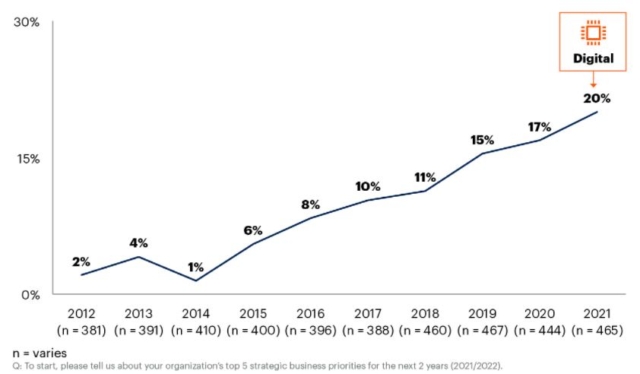
Business processes have changed throughout the years as technology has advanced. 50 years ago, computing was not a widespread function of business. 25 years ago, mobile and social technologies were unheard of. Like anything else, in business, you have to adapt to survive. In today’s world, digitalisation is how you must adapt your business. It’s capable of:
- increasing efficiency.
- giving you a better view of operations.
- keeping your business competitive.
Here’s an example: imagine you have a project to complete with your team at work. Before digitalisation, an email would go out to the team, and ideas would be emailed back and forth. You might set up a meeting or two to hash out details about how to organise a project. Inevitably, the email chain would grow, and there’d be more and more meetings.
Here’s a digitalised version of that interaction: your team, in the office and remotely, all join a dedicated group chat to discuss project details. Your RingCentral group chat turns into a video meeting whenever you need it to in a matter of seconds. Digital data like documents and photos for the project are easily shared, and tasks are ticked off one by one until the project is completed. You finish by archiving all of your documents and photos.
So, which business model seems more appealing?
Key pointers for successful digitalisation
Your digitalisation efforts will depend largely on your industry, like retail, healthcare, education, professional services, financial services, etc. The following are key pointers that apply to all businesses, no matter the industry.
Assess your current digitalisation situation
Before you begin your digital transformation, assess your current operations and see what critical processes can be digitalised. Is there minimal digitalisation? Have you digitalised a few processes? Are you well on your way to being fully digitalised?
Most businesses are in the early stages of their digital transformation, as seen in the chart below.
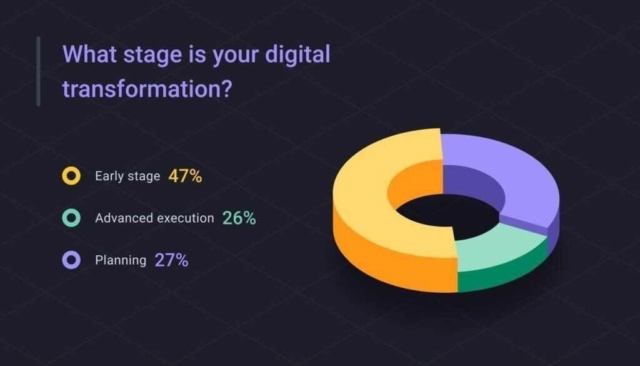
Identify your business’s pain points. Is customer service inundated with misdirected calls? Consider a virtual receptionist to direct calls to the right person. Are customers calling and emailing with the same questions over and over? Set up a chatbot on your website that offers customers a self-help option.
There are plenty of digital technologies to solve your problems, but you have to know where to start, which means you need to assess your workplace functionality.
Once you know where you stand, you can start to organise a plan to implement digitalisation. This process will transform your business, giving you new opportunities made possible through new technology.
Define your digitalisation goals
Set your budget and use its perimeters to define your digitalisation goals. If you run a small or medium-sized business, you may think rapid, company-wide adoption of digitalisation is out of reach, but in reality, it’s not. Because of their size, smaller companies may find it easier to implement changes across the board at an affordable price.
No matter your size or budget, determine your digitalisation goals. Having goals or objectives in mind will help you choose tools and companies to work with. Do you need to boost sales? Invest in an outbound contact centre system. Concerned about the efficiency of your supply chain? Plan to implement a warehouse management system (WMS).
Customer service automation, artificial intelligence (AI), and machine learning sound out of reach, but at their core, they’re tools you can utilise to improve business processes. For example, if one of your digitalisation strategies is to improve the customer experience, an all-in-one call centre system that uses automation and machine learning to optimise the workflow would be ideal.
Make a roadmap for digitalisation and designate a leader
Once you know what you need and where you want to end up, you need a plan to get there. Digitalisation strategies can be multi-layered; you may have several applications or tools to implement. Investigate all of your options thoroughly. Consider a digital solution that integrates with the programs you already use.
Here’s a basic example of a digitalisation roadmap:
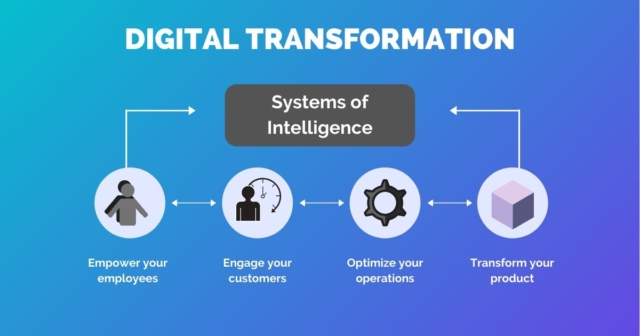
When your roadmap is sorted, assess your network security and make plans to bolster your network if needed. It’s important to evaluate all your network risks before you deploy any new software, so you don’t make a bad situation worse. Develop a thorough security plan with digital, so you’re set from the start.
To oversee the digitalisation, appoint a project leader. Having someone, or a team, in charge of digitalising will make the entire process smoother.
Communicate changes to employees
One of the most important things to do as you move towards digitalisation is to be open and honest with your team about changes in the workplace. Clear communication will reduce conflict down the road. If you’ve previously done things one way, it will be hard to get everyone on board enthusiastically to do things a new way.
The best way to address the changes will depend on your business size and industry. Here are some ways to onboard employees smoothly:
- Be upfront about the timeline for any new tools or applications an employee has to use.
- Hold workshops or seminars for employees detailing digitalisation strategies.
- Have employees complete in-person or virtual training explaining the benefits of digitalisation.
RingCentral Can Help You Digitalise Your Business
RingCentral is the all-in-one business tool that can help your team prioritise digitalisation. In one easy-to-use app, RingCentral helps you get work done with messaging, video, and phone. RingCentral can get your team started with a successful digitalisation plan with some of the best communication tools available.
RingCentral’s unified ecosystem means all your conversations happen in one place. Complete your digitalisation project faster with team messaging, which allows you to chat with internal and external teams, share files, and create dedicated threads for any project or topic.
Save time planning your digitalisation project with HD video meetings. RingCentral’s video meetings give you the functionality of discussing work with your team without any of the hassle of traditional meetings, like booking a room. Join a meeting with a click of a button. You’ll forget you’re on video with carrier-grade voice and video and industry-leading 99.999% uptime. On the go? Flip live meetings between any device without missing a beat.
While messaging, email, and video dominate today’s workspace, you need a reliable business phone solution to get everything done. RingCentral will set you up so you can manage every call, voicemail, and fax with ease.
RingCentral’s cloud PBX system means whether you’re at your desk or on the move, you’ll have everything you need at all times. You can set up advanced call routing, manage your voicemail, and switch from a call to a video meeting with one click.
RingCentral also simplifies the digital transformation process with powerful integrations with the software you already use, like Salesforce, Microsoft Teams, Zapier, HubSpot, and more.
Digitalising will set your business on the right path moving forward, and RingCentral can make that transition much more manageable. Our infrastructure works around the clock to keep you online at all times. You’ll be able to manage one integrated platform with global PBX services in over 40 countries from just about anywhere in the world and be equipped with layers upon layers of security to protect your data and privacy at every level of your business.
Ready to embrace digitalisation?
RingCentral can help you make the digital transition easier. Your team can get everything done, all in one place, from wherever they are in a secure workspace. RingCentral makes digitalising your business easy, so what are you waiting for?
Originally published Nov 07, 2022, updated Nov 30, 2022
